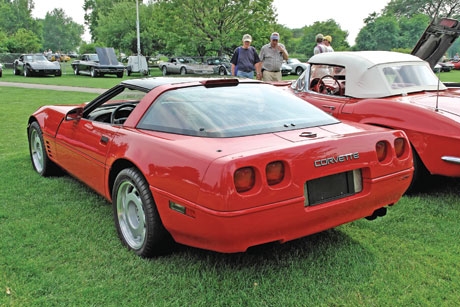The Corvette is an American icon. It is the only true American sports car that has lasted from the ’50s when the sports car market emigrated from Europe to this country, and numerous manufacturers on this side of the pond dabbled in making fun two-seaters. The styling of Corvettes had always been pleasing and powerful, much like in the glory days of the 1967 L88 cars with 430 horsepower (in reality more like 500-plus) that came as convertible or coupe and were generally considered to be one of the most beautifully styled cars ever built. People often wax nostalgic about them in sentences that include the Mercedes Gullwing and the Jaguar XKE.
Then came the gas crunch and the government involvement in building our automobiles. By 1976, the Corvette convertible was gone, and by 1981, the only engine available was an emissions-strangled 190 horsepower version that was pushing a bloated looking, rubber-bumper beast. At least it was still available with a 4-speed manual in ’81. In 1982, the automatic was the only shifter available until the redesigned C4 appeared in 1984.
By 1985, horsepower was sneaking back to 230, and small gains followed each year. By the late 1980s, the brains at GM were thinking long and hard about the future of the Corvette and they made the decision to infuse energy into the brand with a new engine option. Enter the ZR-1. There were actually 84 ZR-1s built in 1989, but none were sold to the public. Nineteen-ninety opened to tremendous excitement in the Corvette world and GM had its halo car. Big premiums over sticker were the dealer norm, and the new ZR-1 was on the fast track to being a sure-fire winner despite the $27,000 ZR-1 premium added to the base $31,979 Corvette price tag. The General sold 3,049 cars with this option in 1990, and the dealers were rumored to be getting an extra $20,000 or so on top of that. True or not, you can bet that few if any were actually sold at sticker. Some were driven, but many were kept in the wrapper in hopes of making a killing in the near future. In 1991, the total build dropped to 2,044; 1992 dropped again to 502 units, and from then until 1995, there were only 448 ZR-1s built each year.
SCM Analysis
Detailing
| Vehicle: | 1990 ZR-1 Coupe |
| Years Produced: | 1990–95 |
| Number Produced: | 6,939 |
| Original List Price: | $58,979 (though most sold for much more) |
| SCM Valuation: | $25,000–$35,000 |
| Tune Up Cost: | $500 |
| Distributor Caps: | $35.89 |
| Chassis Number Location: | Driver’s side dash at windshield |
| Engine Number Location: | Left/right side rear of lower crankcase |
| Club Info: | Corvette Club of America, PO Box 9879, Bowling Green, KY 42102-9789 |
| Website: | www.corvetteclubofamerica.com |
| Alternatives: | 1988–89 Corvette Challenge racer 1991–92 Callaway Corvette |
| Investment Grade: | C |
This car sold for $25,998 at the Mecum Bloomington Gold Corvette auction in St. Charles, Illinois, on June 16, 2007.
The car offered was a very clean, lightly driven example with 18,424 miles on the odometer. Both exterior and interior were red, and the car was equipped with the more desirable 6-speed manual transmission. The mileage looked original, and any light wear issues showed excellent care that belied even the 18,000 miles on the odometer. This car would be a better bet than some of the 0-mile examples available, if you were interested in actually driving the car once in a while. Cars just don’t like to sit.
The price realized seems to fall in the average price range for this car. There are many low- or no-mileage examples to choose from in all years of ZR-1, and the demand hasn’t escalated the average prices yet. The 1990 model-year owners will take the biggest hit when they sell, as they were the ones who shelled out premiums over the $59,000 MSRP when they bought the car.
In 1993, the horsepower went from 375 to 405, and these cars can bring a fairly substantial premium in some instances. There seems to be a concerted effort (especially through the auctions) to jump-start the selling prices on these Corvettes, but that is meeting with little success when the hard dollars drop on the table.
The big bids may be found somewhere in the auction tents to try to prove that the market is rising, but I don’t see many new owners actually buying these cars at the inflated prices. There are just too many fine examples out there, and many are available at the mid-$30,000-range or less.
Perhaps it is now the time to buy, as the prices seem to be holding and I really don’t see any dropping off. This was the most important example of the modern Corvette until the Z06. It has everything Corvette collectors look for—limited production, high horsepower, special parts and exclusive body panels, good handling, and it was only available for six years. There are enough people interested in Corvettes to keep the market alive and well, and the prices will undoubtedly rise in time. The question is simply when
